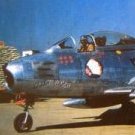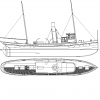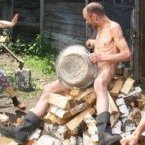-
Posts
6,365 -
Joined
-
Last visited
Reputation Activity
-
 wefalck got a reaction from vaddoc in Cutting Planks
wefalck got a reaction from vaddoc in Cutting Planks
I also had the issue with disc sanders taking off too much too quickly and made myself a little sander that allows to sand plank ends square and at angles:
I also constructed a miniature disc sander around a surplus watchmakers lathe. It is powered by a relatively slow-speed motor with controller. In this way the grinding process can be controlled better. For grinding I use either cheap diamond grit discs or flat discs with fine sandpaper glued on.
-
 wefalck got a reaction from jud in Scanned bulkhead drawings into vector format?
wefalck got a reaction from jud in Scanned bulkhead drawings into vector format?
There is an intermediate method: scan the body plan with sufficient resolution and then import the picture into your (2D) CAD-program. You then can draw in another layer each bulkhead/frame half by tracing the scan with a vector line. It is useful, if your program has a spline-function or similar to smooth the hand-drawn curves. A graphics-tablet is also useful, but I have done it with the mouse or even a track-ball/-pad. Making the drawing big helps to even out the inaccuracies of tracing.
-
 wefalck got a reaction from Mike Y in Cutting Planks
wefalck got a reaction from Mike Y in Cutting Planks
I also had the issue with disc sanders taking off too much too quickly and made myself a little sander that allows to sand plank ends square and at angles:
I also constructed a miniature disc sander around a surplus watchmakers lathe. It is powered by a relatively slow-speed motor with controller. In this way the grinding process can be controlled better. For grinding I use either cheap diamond grit discs or flat discs with fine sandpaper glued on.
-
 wefalck got a reaction from mtaylor in Cutting Planks
wefalck got a reaction from mtaylor in Cutting Planks
I also had the issue with disc sanders taking off too much too quickly and made myself a little sander that allows to sand plank ends square and at angles:
I also constructed a miniature disc sander around a surplus watchmakers lathe. It is powered by a relatively slow-speed motor with controller. In this way the grinding process can be controlled better. For grinding I use either cheap diamond grit discs or flat discs with fine sandpaper glued on.
-
 wefalck got a reaction from Jolley Roger in Cutting Planks
wefalck got a reaction from Jolley Roger in Cutting Planks
I also had the issue with disc sanders taking off too much too quickly and made myself a little sander that allows to sand plank ends square and at angles:
I also constructed a miniature disc sander around a surplus watchmakers lathe. It is powered by a relatively slow-speed motor with controller. In this way the grinding process can be controlled better. For grinding I use either cheap diamond grit discs or flat discs with fine sandpaper glued on.
-
 wefalck got a reaction from John Cheevers in Cutting Planks
wefalck got a reaction from John Cheevers in Cutting Planks
I also had the issue with disc sanders taking off too much too quickly and made myself a little sander that allows to sand plank ends square and at angles:
I also constructed a miniature disc sander around a surplus watchmakers lathe. It is powered by a relatively slow-speed motor with controller. In this way the grinding process can be controlled better. For grinding I use either cheap diamond grit discs or flat discs with fine sandpaper glued on.
-
 wefalck got a reaction from mtaylor in Centering Tools
wefalck got a reaction from mtaylor in Centering Tools
The principle of the tool in the first post is neat, particularly for long, thin parts. I think I will go on to make one myself from metal.
I have used for years this centre-finder (about 50 mm long):
It was and still is a bit pricey at 52€, but this is what you have to pay for quality measuring tools.
-
 wefalck got a reaction from puckotred in Centering Tools
wefalck got a reaction from puckotred in Centering Tools
The principle of the tool in the first post is neat, particularly for long, thin parts. I think I will go on to make one myself from metal.
I have used for years this centre-finder (about 50 mm long):
It was and still is a bit pricey at 52€, but this is what you have to pay for quality measuring tools.
-
 wefalck got a reaction from druxey in Centering Tools
wefalck got a reaction from druxey in Centering Tools
The principle of the tool in the first post is neat, particularly for long, thin parts. I think I will go on to make one myself from metal.
I have used for years this centre-finder (about 50 mm long):
It was and still is a bit pricey at 52€, but this is what you have to pay for quality measuring tools.
-
 wefalck got a reaction from jud in Coiling Lines Option
wefalck got a reaction from jud in Coiling Lines Option
As I certainly stated here repeatedly, I never use CA glues for anything else, but proper joints. I certainly do not use it to re-enforce any rigging. The lacquer or varnish I use is called (in German) zapon-varnish. It cellulose-based and contains also components that keep it slightly elastic. It's main traditional use is to protect silverware and brass (instruments) from tarnishing.
The very varnish also keeps rope coils in place. Of course, one can use a lacquer or varnish as glue too.
Below a couple of pictures of various types of coils, all coerced in place with varnish. The first picture shows how the coils are shaped and kept in their place, while the solvent evaporates - usually in a few minutes.
-
 wefalck got a reaction from thibaultron in Coiling Lines Option
wefalck got a reaction from thibaultron in Coiling Lines Option
As I certainly stated here repeatedly, I never use CA glues for anything else, but proper joints. I certainly do not use it to re-enforce any rigging. The lacquer or varnish I use is called (in German) zapon-varnish. It cellulose-based and contains also components that keep it slightly elastic. It's main traditional use is to protect silverware and brass (instruments) from tarnishing.
The very varnish also keeps rope coils in place. Of course, one can use a lacquer or varnish as glue too.
Below a couple of pictures of various types of coils, all coerced in place with varnish. The first picture shows how the coils are shaped and kept in their place, while the solvent evaporates - usually in a few minutes.
-
 wefalck got a reaction from Ferit in Coiling Lines Option
wefalck got a reaction from Ferit in Coiling Lines Option
As I certainly stated here repeatedly, I never use CA glues for anything else, but proper joints. I certainly do not use it to re-enforce any rigging. The lacquer or varnish I use is called (in German) zapon-varnish. It cellulose-based and contains also components that keep it slightly elastic. It's main traditional use is to protect silverware and brass (instruments) from tarnishing.
The very varnish also keeps rope coils in place. Of course, one can use a lacquer or varnish as glue too.
Below a couple of pictures of various types of coils, all coerced in place with varnish. The first picture shows how the coils are shaped and kept in their place, while the solvent evaporates - usually in a few minutes.
-
 wefalck got a reaction from lmagna in Coiling Lines Option
wefalck got a reaction from lmagna in Coiling Lines Option
As I certainly stated here repeatedly, I never use CA glues for anything else, but proper joints. I certainly do not use it to re-enforce any rigging. The lacquer or varnish I use is called (in German) zapon-varnish. It cellulose-based and contains also components that keep it slightly elastic. It's main traditional use is to protect silverware and brass (instruments) from tarnishing.
The very varnish also keeps rope coils in place. Of course, one can use a lacquer or varnish as glue too.
Below a couple of pictures of various types of coils, all coerced in place with varnish. The first picture shows how the coils are shaped and kept in their place, while the solvent evaporates - usually in a few minutes.
-
 wefalck got a reaction from Bob Cleek in Coiling Lines Option
wefalck got a reaction from Bob Cleek in Coiling Lines Option
As I certainly stated here repeatedly, I never use CA glues for anything else, but proper joints. I certainly do not use it to re-enforce any rigging. The lacquer or varnish I use is called (in German) zapon-varnish. It cellulose-based and contains also components that keep it slightly elastic. It's main traditional use is to protect silverware and brass (instruments) from tarnishing.
The very varnish also keeps rope coils in place. Of course, one can use a lacquer or varnish as glue too.
Below a couple of pictures of various types of coils, all coerced in place with varnish. The first picture shows how the coils are shaped and kept in their place, while the solvent evaporates - usually in a few minutes.
-
 wefalck got a reaction from thibaultron in Coiling Lines Option
wefalck got a reaction from thibaultron in Coiling Lines Option
Not sure what you mean by 'fumes'. You would use only a tiny drop of lacquer/varnish, applied with a brush, you wouldn't dowse the model in it. The stuff I am using is very similar to nail-varnish and smells like that as well. Actually, I like that smell.
-
 wefalck got a reaction from Matrim in Knots
wefalck got a reaction from Matrim in Knots
The real problem with too bulky knots is that the thread used is to thick. One should carefully select the size according to scale.
When it would be descernible at the scale, I tend to use the actual prototype knot. Otherwise, I am using most frequently the clove hitch and half-hitch. I prefer the clove hitch over the constrictor knot, if there is a chance that I might need to untie it again.
Belaying would also follow prototype practice, if at all practicable.
Where splices were used, I would make false splices, i.e. I would draw the end through itself twice or three times with a needle.
-
 wefalck got a reaction from Roger Pellett in Coiling Lines Option
wefalck got a reaction from Roger Pellett in Coiling Lines Option
Not sure what you mean by 'fumes'. You would use only a tiny drop of lacquer/varnish, applied with a brush, you wouldn't dowse the model in it. The stuff I am using is very similar to nail-varnish and smells like that as well. Actually, I like that smell.
-
 wefalck got a reaction from thibaultron in Coiling Lines Option
wefalck got a reaction from thibaultron in Coiling Lines Option
I tend to use thin organic-solvent based lacquer for this. Drape/coil it and then soak in the lacquer, so that the rope becomes stiff. Further adjustments can be made by applying a drop of the respective thinner - the rope becomes soft again and can be coerced into shape. If you find a solvent for the glue-stick glue, this may also be an option.
-
 wefalck got a reaction from BANYAN in Coiling Lines Option
wefalck got a reaction from BANYAN in Coiling Lines Option
I tend to use thin organic-solvent based lacquer for this. Drape/coil it and then soak in the lacquer, so that the rope becomes stiff. Further adjustments can be made by applying a drop of the respective thinner - the rope becomes soft again and can be coerced into shape. If you find a solvent for the glue-stick glue, this may also be an option.
-
 wefalck got a reaction from popeye the sailor in HMCSS Victoria 1855 by BANYAN - 1:72
wefalck got a reaction from popeye the sailor in HMCSS Victoria 1855 by BANYAN - 1:72
At least the level of evidence on her is quite high, when I compare this with the navies of my home-country of the same period - usually we only have some pictures taken from the distance, if any at all, and virtually no plans 😥
-
 wefalck got a reaction from mtaylor in Scanned bulkhead drawings into vector format?
wefalck got a reaction from mtaylor in Scanned bulkhead drawings into vector format?
There is an intermediate method: scan the body plan with sufficient resolution and then import the picture into your (2D) CAD-program. You then can draw in another layer each bulkhead/frame half by tracing the scan with a vector line. It is useful, if your program has a spline-function or similar to smooth the hand-drawn curves. A graphics-tablet is also useful, but I have done it with the mouse or even a track-ball/-pad. Making the drawing big helps to even out the inaccuracies of tracing.
-
 wefalck got a reaction from jud in Coiling Lines Option
wefalck got a reaction from jud in Coiling Lines Option
I tend to use thin organic-solvent based lacquer for this. Drape/coil it and then soak in the lacquer, so that the rope becomes stiff. Further adjustments can be made by applying a drop of the respective thinner - the rope becomes soft again and can be coerced into shape. If you find a solvent for the glue-stick glue, this may also be an option.
-
 wefalck got a reaction from thibaultron in Scanned bulkhead drawings into vector format?
wefalck got a reaction from thibaultron in Scanned bulkhead drawings into vector format?
There is an intermediate method: scan the body plan with sufficient resolution and then import the picture into your (2D) CAD-program. You then can draw in another layer each bulkhead/frame half by tracing the scan with a vector line. It is useful, if your program has a spline-function or similar to smooth the hand-drawn curves. A graphics-tablet is also useful, but I have done it with the mouse or even a track-ball/-pad. Making the drawing big helps to even out the inaccuracies of tracing.
-
 wefalck got a reaction from popeye the sailor in HMCSS Victoria 1855 by BANYAN - 1:72
wefalck got a reaction from popeye the sailor in HMCSS Victoria 1855 by BANYAN - 1:72
I was going to ask these questions too. It seems like an unusual place to store the hammocks, as it would be difficult to cover them in foul weather. Or were they put there only to dry ? But why then rolled ?
-
 wefalck got a reaction from Old Collingwood in HMCSS Victoria 1855 by BANYAN - 1:72
wefalck got a reaction from Old Collingwood in HMCSS Victoria 1855 by BANYAN - 1:72
Doing these investigations and finding out how things work(ed) is one of the most satisfying aspects in shipmodel building ... the second half of the 19th is particularly interesting in this respect with all the techonological revolutions and those 'patent' thingies.



.thumb.jpg.6fd4c1b78768bb3efd745ab810936005.jpg)












